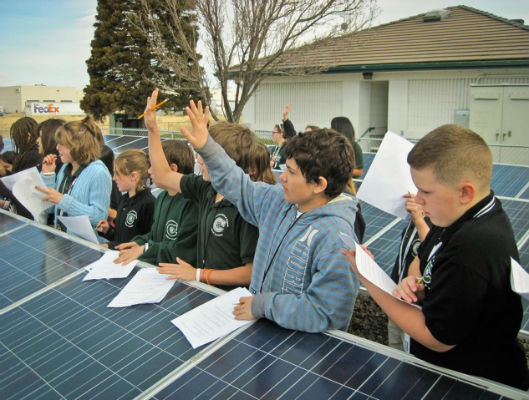The most pressing issues of our time are often the most polarized, and this is certainly true of climate change. To get past the political gridlock, many environmental leaders urge advocates to make the issue more visible, more emotional, and, above all, more urgent in the minds of everyday citizens.
The desire for urgency makes sense in many ways. Heat-trapping emissions from fossil fuels have already disrupted Earth’s climate system. At this very moment, the resulting changes are undermining human health and harming the natural places on which people depend. Our action or inaction on climate policy today will continue to reverberate, for better or worse, far into the future.

But from a communications perspective, we’re not so sure that upping the urgency factor is the best approach. The full-frontal, factual assault hasn’t been sufficient to motivate behavior and policy changes. Half of the heat-trapping emissions in our atmosphere were released after 1988, the year in which NASA scientist James Hansen told a congressional hearing that Earth’s atmosphere was already warming. “It is time to stop waffling so much and say that the evidence is pretty strong that the greenhouse effect is here,” he said. In the three decades since, as scientists’ understanding has consolidated, public opinion has only become more divided. Why?
Some communicators have intentionally sowed doubt, confusion, and science skepticism. When public opinion is divided, policy progress slows, as elected officials and other policymakers hesitate to take stances that alienate constituents. Knowing this, vested interests often manufacture misunderstanding or polarize issues. This is why some lobbyists work to foster political polarization as part of their toolkit for safeguarding an issue from regulation. The best-documented example is the tobacco industry’s efforts to instill skepticism about the negative health effects of smoking, while also encouraging smokers to think of their consumption as an individual “right.” In a similar vein, the fossil fuel industry has encouraged both doubt and controversy on climate change.
 Middle school students on a field trip learning about solar panels in Reno, Nevada. (Photo by Jessica Reeder/BlackRockSolar)
Middle school students on a field trip learning about solar panels in Reno, Nevada. (Photo by Jessica Reeder/BlackRockSolar)
Advocates are well aware of active disinformation campaigns like these. And their intuition to fight lies with truth—to pour on the facts—is perfectly understandable. But here’s the problem: Countering misinformation with fact-based rebuttals rarely works. In fact, a good deal of research into the psychology of persuasion finds that yelling louder from an entrenched position doesn’t just fall flat, it can actually be counterproductive.
Advocates need not fall into this trap, whether they work on climate or on other issues. Instead, they can make progress by looking for “side doors” to engage people in different perspectives, rather than trying to knock down the front door with a barrage of facts. These side doors frame a problem in ways that aren’t clearly marked as “Left” or “Right,” leaving open the possibility of true dialogue with diverse, even antagonistic, audiences.
So how can advocates spot a side door when they need one? Our work on recent climate change communication projects—including the National Network for Ocean and Climate Change Interpretation (NNOCCI), a collaborative effort to support climate communication efforts at zoos and aquariums, and the Climate Visuals project, a research-based repository of climate-related imagery—has revealed some of the telltale signs to these oblique entryways. Here are a few ways to find them:
1. They’re in the public square, but far from the boxing ring.
Advocates can find space for depolarized discussions by looking for communications opportunities off the beaten path, away from the boisterous “argument culture” fostered by sensational journalism and dog-eat-dog politics. In our work with zoos and aquariums, for instance, we found that these informal, family-oriented spaces provide opportunities for people to learn about climate change in non-threatening and personally meaningful ways.
With a well-coordinated plan for embedding new frames into the ways these institutions engage the public, this approach can have a surprisingly wide reach. There are more visits to American zoos and aquariums each year than to all major-league sports events combined. What’s more, people who visit cultural institutions are generally more politically engaged than those who don’t. By equipping and organizing communicators in cultural and community institutions, it’s possible for advocates on a range of issues to move away from partisan echo chambers and into places with broader civic resonance.
2. A trustworthy voice invites you in.
When the “usual suspects” are the only voices on an issue, the public quickly begins to doubt their authenticity. Ensuring that trusted messengers are part of the framing effort can help avoid this problem. Our work on the Climate Visuals project revealed that candid images of real people were viewed as more authentic and engaging than staged photos, and that imagery of easily identifiable “environmentalists” protesting increased people’s cynicism, whereas images of regular citizens engaged in climate change solutions tended to produce positive reactions in viewers.
One of NNOCCI’s secrets of success is that the messengers work for aquariums, not climate advocacy organizations. Research suggests that Americans trust aquariums and museums more than they trust the media, government sources, and even NGOs. As a result, we found that although Americans tend not to talk about climate change very often, they were willing and eager to discuss the topic with staff who interpret and explain exhibits.
This lesson holds true for other cause communicators: To depolarize an issue, redouble your efforts to cultivate diverse voices, looking especially for messengers who the public doesn’t already associate with the topic.
3. People can see how to let themselves in.
The local, immediate concerns people frequently deal with in their own communities provide opportunities to help them connect with bigger issues. Focusing on the day-to-day and longer-term decisions that people already have to make instantly increases the salience of what you have to say. What’s more, talking about an issue at a local or regional level can side-step much of the polarization we see on climate change, which is driven largely by party elites and other powerful influencers.
The recent response to the United States’ withdrawal from the Paris climate agreement illustrates this dynamic. After the federal government pulled out of the Paris accords, the doors of discourse marked “Right” and “Left” revolved through familiar, unproductive debates: science skepticism vs. scientific authority, global competition vs. global leadership, economy vs. environment, and political cronyism vs. political activism. Meanwhile, states and cities found another entry point, asking what they could do in the here and now to respond, using local, extensive knowledge about how climate change will affect their regions. This approach leveraged the reality that all Americans—including governors and mayors, small business owners, university administrators, and housing authority directors—can not only solve local problems created by a changing climate, but also be part of global solutions to reduce future harm.
4. Side doors let in the light.
Finally, “side doors” can redirect people away from fight-or-flight instincts and toward curiosity and resolve. The “crisis” door so frequently used by social change advocates often leads to a dead end. Images and frames such as bright-red temperature projections, a starving polar bear stranded on an ice floe, or a parched landscape devoid of all life may activate some people’s moral concerns, but they lead others to experience “apocalypse fatigue.” Such emotionally overwhelming messaging can cause people to actively turn away from the issue.
Highlighting the good that can come from public engagement and civic action is an alternative approach. For example, NNOCCI’s exhibit interpreters talk about community solar programs in which neighbors jointly support and subscribe to a localized renewable power source. This demonstrates feasible steps away from fossil fuels. Or they describe sector-wide energy audits of public buildings and university campuses, illustrating energy efficiency on a scale that is intuitively more meaningful than switching lightbulbs at home.
A solutions-oriented frame doesn’t require that we sweep problems under the communicative rug. Instead, it takes advantage of Americans’ self-perception as people who roll up their sleeves and get to work when faced with a challenge. This framing encourages advocates to adopt a more fully elaborated call for help—from “Fire!” to “We have a fire! Bucket brigades work. Let’s get creative. Join us here!”
Side doors offer routes to elevate public discourse
Rather than trying to force agreement through a deluge of facts and messenger-driven values, advocates can help to restore public dialogue—where we exchange and consider ideas—through these reframed entry points. Once the public enters, we are more likely to find a place where we can make progress.
Support SSIR’s coverage of cross-sector solutions to global challenges.
Help us further the reach of innovative ideas. Donate today.
Read more stories by Ezra Markowitz & Julie Sweetland.

